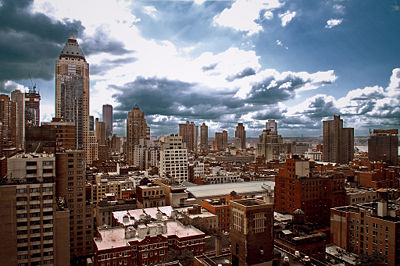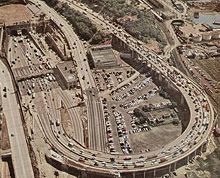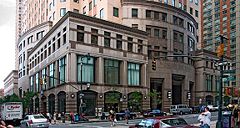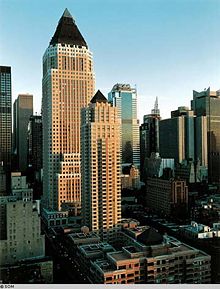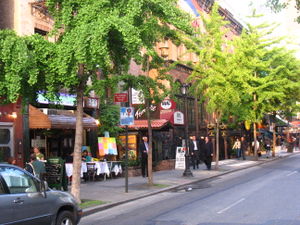From The Peopling of New York City
Contents |
Gentrification
Gentrification is a process widely associated with the dynamics of a changing neighborhood, more specifically the transition from being a run-down aging neighborhood into a prosperous one. This process is always accompanied with the influx of investors and the building of new structures. Furthermore there is a noticeable change in the local population as well, that is, often the poor residents of that area are displaced by middle class and more affluent population as the neighborhood gradually loses its deteriorating character. Gentrification however may not always bring about exclusively positive change, sometimes it may hurt the residents of a certain area and the local businesses.
Paterns From The Past
The name Hell's Kitchen is commonly associated with the neighborhood's infamous past. A past that included such stigmatizing elements as drugs, prostitution, street gangs, organized Irish crime circles, bootleggers, gambling and poverty. But for most of its time Hell's Kitchen had blue collar immigrant families living in tenements as the majority of its population. Most of these immigrants were Irish, Italians or Greeks that worked as longshoremen on docks or stage hands in theaters. When in 1940's Puerto Rican Immigrants were introduced to this region, the ethnic differences between this new immigrant group and the immigrants that were already established in this area escalated into a violent conflict more notoriously known as the West Side Story.
Attempts of improving the neighborhood included the construction of the Miller Elevated Highway, the Lincoln Tunnel, and the Port Authority Terminal, but these new structures had a rather negative effect; they caused an increase in both traffic and crime.
Transition Times
Attempts of improving the neighborhood included the construction of the Miller Elevated Highway, the Lincoln Tunnel, and the Port Authority Terminal, but these new structures had a rather negative effect; they caused an increase in both traffic and crime.
Present Turmoils
But Hell's Kitchen was originally a working class immigrant community, and when the neighborhood was in trouble the community responded. For example: in 1960 there was an attempt at renaming the are to Clinton in order to get rid of the unwanted negative fame associated with the past years characterized by organized crime. In the last two decades Hell's Kitchen has made a tremendous transition from its from its corrupt past, and into a golden opportunity for investors. This trend is mainly due to the fact that this neighborhood is in direct proximity to the waterfront,transportation, midtown's entertainment and attraction area, and office buildings.
And while such large scale projects as the Conventional Center and the World Plaza seem to shift the neighborhood's character, the local populations is fighting against unwanted change in order to maintain the character of Hell's Kitchen – that of a mixed income, mixed use neighborhood. The fears of most residents on this area is that gentrification will eventually drive out small businesses and make the residential prices sky rocket making this neighborhood available only to the wealthier part of the general population.
A display of this tormented struggle is the Special Clinton District that was enacted in 1974, according to chapter 6 (of this document) this document was designed to “ promote and protect public health, safety, general welfare and amenity”. The document further states that the goals of the Special Clinton District are:
(a) to preserve and strengthen the
residential character of the community
(b) to permit rehabilitation and new
construction within the area in character with the existing
scale of the community and at rental levels which will not
substantially alter the mixture of income groups presently
residing in the area
(c) to preserve the small-scale
character and variety of existing stores and activities and to
control new commercial uses in conformity with the existing
character of the area
(d) to provide amenities, such as
street trees, to improve the physical environment
(e) to restrict demolition of buildings
that are suitable for rehabilitation and continued residential use
(f) to promote the most desirable use of land in the area and thus to conserve the value of land and buildings, and thereby protect the City's tax revenues, consistent with the foregoing purposes
This document was enacted as a response to large scale demolitions that threatened such landmarks as the Windermere complex, not to mention the overall character of this area. Furthermore the purpose of this document seems to be to allow improvement of this neighborhood, improvement that will benefit the residents instead of driving them away from their homes. Nevertheless today Hell's kitchen is undergoing gentrification due to its proximity to midtown. This trend can be traced to the Off Broadway theaters, luxury condominiums and restaurants(ref) , and tenants that sell their apartment that have increased tremendously in price during the last decade. Another distinct trend in the rise of the annual household income that grew from 37000 in 1990 to 47000 in 2000. (ref)
All these factors may put pressure on a community. But fortunately to this day Hell's Kitchen remains an immigrant neighborhood where one could experience a tremendous variety of ethnic food on the Restaurant Row. Which is in fact a finger print of the collective heritage of the generations of immigrants that have lived here.
And while young professionals, followed by new businesses, seem to move into the neighborhood, the local population struggles to maintain Hell's Kitchen character. Because after all the consequences of this neighborhood's gentrification would be its transformation into another out-of reach residential area and the name Hell's Kitchen will no longer resonate a sense of pride and belonging in its residents.
References
- Hell's Kitchen, Swept Out and Remodeled - Region - New York Times
- Keeping the ‘Kitchen’ in Clinton (1/5) - hellskitcen.net
- The Closer: Hell's Kitchen is still hot - The Daily News
- The Turf of Gangs and Gangsters - Weekend Explorer - The New York Times
